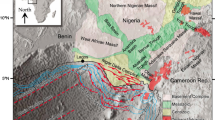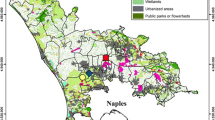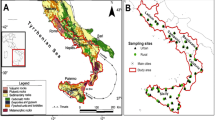Abstract
Background, Aim and Scope
Polycyclic aromatic hydrocarbons (PAHs) have gained serious attention in the scientific community due to their persistence and toxic potential in the environment. PAHs may pose a risk to ecosystem health. Along the Mosel River/Germany, a tributary of the river Rhine, PAHs were found at significantly high concentrations (> 20 mg kg−1, German national guideline value Z2, LAGA 1998). These high concentrations were detected during the construction of a storm water retention basin, in which the contaminated soils had to be removed and treated as hazardous waste. This resulted in higher construction costs for implementing flood prevention measures, but did not address the origin of these PAHs and its distribution along Mosel River. Hence, for future flood prevention projects, it is necessary to estimate the extent of PAH contamination along the Mosel River. The aim of the study is to determine the extent of PAH contamination in soils collected along Mosel and Saar River, and to obtain a first insight into the origin of the PAH contamination in this region.
Materials and Methods
In total twenty seven sample sites were investigated. Forty two single samples were collected along a 167 km distance of Mosel River and six samples were collected along a 20 km distance of Saar River. Soil samples were collected at a depth of 0 to 2 m with a stainless steel corer (▫ 8 cm). Each 2 m sample was further separated into two sub-samples (0–1 m and 1–2 m). The sixteen EPA PAHs and three additional PAHs (1methylnaphthalene, 2methylnaphthalene and perylene) were analysed with gas chromatography mass spectrometry (GC-MS). For soil characterisation, total organic carbon (TOC), grain size, microscope and X-ray diffraction (XRD) analysis were performed.
Results
Grain size for all soil samples was classified as a mixture of sand and silt. XRD analysis showed that all samples were dominated by quartz. Some clay minerals, such as illite and montmorillonite and feldspars, i.e. anorthoclase and orthoclase, were found in minor quantities. TOC ranged from 0.1% to 13%. Microscope analysis showed black coal particles in the majority of the soils collected from the Saar River and part of the Mosel River (downstream of the confluence of Saar and Mosel River). The black particles were not found further upstream along Mosel River. The sum of nineteen PAHs in the soil samples was up to 81 mg kg−1 dry weight (dw). Most soil samples showed a relationship between the presence of coal particles and PAH concentrations.
Discussion
Elevated PAH concentrations were found in all soil samples collected from Saar River and downstream Mosel River. Due to former coal mining activities in the Saarland, Germany, there is a strong evidence that the majority of the PAH contamination in the soils downstream Mosel River are linked to these mining activities. Upstream Mosel River coal particles were hardly found although PAH concentrations were high. Therefore another PAH source has to be responsible for these concentrations. PAH distribution patterns indicate a pyrogenic PAH input upstream Mosel River and a mixed input (petrogenic and pyrogenic) downstream Mosel River.
Conclusions
Due to PAH distribution patterns, the contamination along the upstream of the Mosel River is probably linked to atmospheric depositions and other sources not linked to coal mining activities. Downstream Mosel River the PAH distribution patterns reflect former coal mining activities. We could corroborate for the first time that coal mining resulted in a serious problem of an extensive PAH contamination at Saar and Mosel River floodplain soils.
Recommendations and Perspectives
Coal mining activities have a strong impact on the neighbouring regions (Johnson and Bustin 2006, Short et al. 1999, Stout et al. 2002). It is known that coals exhibit relative high PAH concentrations, especially in the low molecular weight PAHs (Chapman et al. 1996, Radke et al. 1990). However, PAHs in coals are hardly bioavailable (Chapman et al. 1996) and hence may have less adverse effects on exposed biota. They can act as sink for other hydrophobic contaminants. For the assessment of the environmental impact, a detailed study of the sorption and desorption behaviour of PAHs linked to coal particles should be carried out.
Similar content being viewed by others
References
ARGE Elbe (2001): Wassergütedaten der Elbe. Zahlentafel 1999, Arbeitsgemeinschaft für die Reinhaltung der Elbe, Hamburg
Barron MG, Holder E (2003): Are exposure and ecological risks of PAHs underestimated at petroleum contaminated sites? Human and Ecological Risk Assessment 9(6) 1533–1545
Bucheli TD, Blum F, Desaules A, Gustafsson Ö (2004): Polycyclic aromatic hydrocarbons, black carbon, and molecular markers in soils of Switzerland. Chemosphere 56, 1061–1076
Budzinski H, Jones I, Bellocq J, Piérard C, Garrigues P (1997): Evaluation of sediment contamination by polycyclic aromatic hydrocarbons in the Gironde estuary. Marine Chemistry 58(1–2) 85–97
Chapman PM, Downie J, Maynard A, Taylor LA (1996): Coal and deodorizer residues in marine sediments — Contaminants or pollutants? Environmental Toxicology and Chemistry 15(5) 638–642
Deng H, Peng P, Huang W, Song J (2006): Distribution and loadings of polycyclic aromatic hydrocarbons in the Xijiang River in Guangdong, South China. Chemosphere 64(8) 1401–1411
DIN ISO 11277: Soil quality — Determination of particle size distribution in mineral soil material — Method by sieving and sedimentation (ISO 11277:1998+ ISO 11277:1998 Corrigendum 1:2002)
Fang G-C, Chang K-F, Lu C, Bai H (2004): Estimation of PAHs dry deposition and BaP toxic equivalency factors (TEFs) study at urban, industry park and rural sampling sites in central Taiwan, Taichung. Chemosphere 55, 787–796
Fernandes MB, Sicre M-A, Boireau A, Tronczynski J (1997): Polyaromatic hydrocarbon (PAH) distributions in the Seine River and its estuary. Marine Pollution Bulletin 34(11) 857–867
Fernández P, Vilanova RM, Martínez C, Appleby P, Grimalt JO (2000): The historical record of atmospheric pyrolytic pollution over Europe registered in the sedimentary PAH remote mountain lakes. Environmental Science & Technology 34(10) 1906–1913
Gocht T, Moldenhauer K-M, Püttmann W (2001): Historical record of polycyclic aromatic hydrocarbons (PAH) and heavy metals in floodplain sediments from the Rhine River (Hessisches Ried, Germany). Applied Geochemistry 16, 1707–1721
Hawthorne SB, Miller DJ, Kreitinger JP (2006): Measurement of total polycyclic aromatic hydrocarbon concentrations in sediments and toxic units used for estimating risk to benthic invertebrates at manufactured gas plant sites. Environmental Toxicology and Chemistry 25(1) 287–296
International Agency for Research of cancer (IARC) (1983): Polynuclear Aromatic Compounds, Part I, Chemical, environmental and experimental Data. Lyon, World Health Organization
International Kommissionen zum Schutze der Mosel und der Saar (IKSMS) (2005): Wasserrahmen Richtlinie — Bestandsaufnahme Mosel-Saar (Teil B), Report IKSMS, 178 pp
Johnson R, Bustin RM (2006): Coal dust dispersal around a marine coal terminal (1977–1999), British Colombia: The fate of coal dust in the marine environment. International Journal of Coal Geology 68(1–2) 57–69
Jones KC, Stratford JA, Waterhouse KS, Furlong ET, Giger W, Hites RA, Schaffner C, Johnston AE (1989): Increases in the polynuclear aromatic hydrocarbon content of an agricultural soil over the last century. Environmental Science & Technology 23(1) 95–101
Jones KC, Stratford JA, Waterhouse KS, Vogt NB (1989): Organic contaminants in Welsh soils: Polynuclear aromatic hydrocarbons. Environmental Science & Technology 23(5) 540–550
Landesarbeitsgemeinschaft Boden (LABO) (2003): Hintergrundwerte für anorganische und organische Stoffe in Böden. Bund Länder Arbeitsgemeinschaft Bodenschutz, pp 170
Landesarbeitsgemeinschaft Abfall (LAGA) (1998): Anforderungen an die stoffliche Verwertung von mineralischen Reststoffen/Abfällen, Technische Regeln. Länderarbeitsgemeinschaft Abfall
Liu M, Hou LJ, Yang Y, Zou HX, Lu JH, Wang XR (2001): Distribution and sources of polycyclic aromatic hydrocarbons in intertidal flat surface sediments from Yangtze estuary, China. Environmental Geology 41, 90–95
Loibner AP, Szolar OHJ, Braun R, Hirmann D (2003): Toxicity testing of 16 priority polycyclic aromatic hydrocarbons using Lumistox. Environmental Toxicology and Chemistry 23(3) 557–564
Ma LL, Chu SG, Wang XT, Cheng HX, Liu XF, Xu XB (2005): Polycyclic aromatic hydrocarbons in the surface soils from outskirts of Beijing, China. Chemosphere 58, 1355–1363
Neff JM, Stout SA, Gunstert DG (2005): Ecological risk assessment of polycyclic aromatic hydrocarbons in sediments: identifying sources and ecological hazard. Integrated Environmental Assessment and Management 1(1) 22–33
Olajire AA, Altenburger R, Küster E, Brack W (2005): Chemical and ecotoxicological assessment of polycyclic aromatic hydrocarbon — contaminated sediments of the Niger Delta, Southern Nigeria. The Science of the Total Environment 340, 123–136
Page DS, Boehm PD, Douglas GS, Bence AE, Burns WA, Mankiewicz PJ (1996): The natural petroleum hydrocarbon background in subtidal sediments of Prince William Sound, Alaska. Environmental Toxicology and Chemistry 15, 1266–1281
Radke M, Willsch H, Teichmüller M (1990): Generation and distribution of aromatic hydrocarbons in coals of low rank. Organic Geochemistry 15(6) 539–563
Short JW, Kvenvolden KA, Carlson PR, Hostettler FD, Rosenbauer RJ, Wright BA (1999): Natural hydrocarbon background in benthic sediments of Prince William Sound, Alaska: Oil vs coal. Environmental Science & Technology 33(1) 34–42
Sporstöl S, Gjös N, Lichtenthaler RG, Gustavsen KO, Urdal K, Oreld F, Skel J (1983): Source identification of aromatic hydrocarbons in sediments using GC/MS. Environmental Science & Technology 17(5) 282–286
Stout SA, Emsbo-Mattingly S, Uhler AD, McCarthy K (2002): Environmental forensics particulate coal in soils and sediments-recognition and potential influences on hydrocarbon fingerprinting and concentration. Soil Sediment & Water Juni 2002
Trapido M (1999): Polycyclic aromatic hydrocarbons in Estonian soil: contamination and profiles. Environmental Pollution 105, 67–74
United States Environmental Protection Agency (US EPA) (1989): Risk assessment guidelines for Superfund. Human health evaluation manual part A. Office Emergency and Remedial Response. Washington DC
Vliex M (1994). Kohlenpetrographische und oragnisch-geochemische Untersuchungen an Kohlen und Sedimentgesteinen des Saar-Nahe-Beckens-Ein Beitrag über die Bedeutung geochemischer Fossilien als Anzeiger für Veränderungen der Flora zwischen dem Westfal C und dem Unterrotliegenden. Fakultät für Bergbau, Hüttenwesen und Geowissenschaften. Aachen, Rheinisch-Westfälische Technische Hochschule Aachen, pp 224
Water and Shipping Authority Trier (2004): pers. comm.
White PA (2002): The genotoxicity of priority polycyclic aromatic hydrocarbons in complex mixtures. Genetic Toxicology and Environmental Mutagenesis 515, 85–98
Wieber G (2005): PAK-Anreicherungen in Hochflutsedimenten an einem Standort der Mittelmosel. Altlasten Spektrum 4, 227–230
Wild SR, Jones KC (1995): Polynuclear aromatic hydrocarbons in the United Kingdom environment: A preliminary source inventory and budget. Environmental Pollution 88, 91–108
Youngblood WW, Blumer M (1975): Polycyclic aromatic hydrocarbons in the environment: homologous series in soils and recent marine sediments. Geochimica et Cosmochimica Acta 39, 1303–1314
Zhang HB, Luo YM, Wong MH, Zhao QG, Zhang GL (2006): Distributions and concentrations of PAHs in Hong Kong soils. Environmental Pollution 141, 107–114
Author information
Authors and Affiliations
Corresponding author
Additional information
ESS-Submission Editor: Dr. Ralph Portier (rportie@lsu.edu)
Rights and permissions
About this article
Cite this article
Pies, C., Yang, Y. & Hofmann, T. Distribution of polycyclic aromatic hydrocarbons (PAHs) in floodplain soils of the Mosel and Saar River. J Soils Sediments 7, 216–222 (2007). https://doi.org/10.1065/jss2007.06.233
Received:
Accepted:
Published:
Issue Date:
DOI: https://doi.org/10.1065/jss2007.06.233




